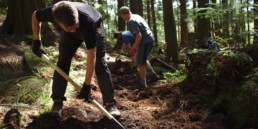Managing Risk With Trail Design
Most trails currently in use were designed before the creation of the mountain bike and were therefore not designed to maximize biking experience or provide adequate opportunities for skill progression. Seeking physical challenge in the outdoors is a long-standing human practice. Below are some principles of trail design, construction techniques and management strategies for managing risk.
Basic concepts of using trail design to manage risk
- Reduce Injury Frequency
- Reduce Injury Severity
- Reduce Injury Consequences
- Maintain Risk Management Protocols
Tips for Reducing Injury Severity
Warnings
- Signs play a vital role in managing risk
- Consider a perimeter (fence, vegetation – every user is warned of potential risk no matter how they enter the trail system)
- The main trailhead kiosk could describe trail difficulty using a trail rating system
- Provide signage that alerts users to elements of increased risk
- Use language that appeals to users
- Include warnings about natural outdoor hazards (such as deadfall, weather, animals, etc.)
Filters
- A trail filter, sometimes referred to as a gateway or qualifier, is a high-skill-level, low-consequence obstacle that demonstrates the difficulty of the upcoming trail or trail feature.
- Consider using filters at the beginning of each advanced trail and just before technical features
- By making the entrances to technical trails and features difficult, you prevent unprepared riders from overstepping their abilities.
- Build with low consequence, easy exit
- Should require same skill as the features on the trail
- Filter must be path of least resistance
Provide optional lines
- Consider offering an easier, alternate route around a technical feature
- Allows different ability level riders to ride together
- On advanced trails, the technical trail feature can be located on the main line, with an easier option to the side. On intermediate or beginner routes, technical trail features could be outside the main trail flow
- Make easier line longer, more difficult line shorter
- Optional lines can potentially be in the same corridor as the main trail; for example, a drop-off could vary in height from one side of the trail to the other
Introduce challenges to users sequentially so they can enhance their skills in a managed environment.
Include skills areas/challenge parks
- Construct a practice area with a wide variety of challenging obstacles, from easy to difficult.
- Provides a low risk area to learn skills required to successfully ride trail
- Locate at trailhead
- The most challenging features should mirror the most difficult obstacles users can expect to encounter on the trail system.
- Possible elements include low skinnys, rock gardens, rollers, small drops, chicanes, fake root web, boulders
- Another idea is to offer regularly scheduled skills clinics. In addition to teaching riding techniques, include tips on responsible trail use
Provide good sight lines
- Add good sight lines at intersections and bi-directional trails
Tips for Reducing Injury Frequency
Fall zone management
- A fall zone is the area adjacent to a technical trail feature, which provides a clear landing for a rider who has failed to negotiate the obstacle
- Consider removing branches, stumps, logs, rocks, and other protruding objects that could cause injury if the fall zone is utilized
- Backcountry – less clearing, remove sharp unyielding objects
- Frontcountry – option is to add mulch or dirt to further soften a fall zone
Reduce MOI (mechanism of injury)
- Reduce speeds with slow speed turns and technical features
- Reduce fall height
- Consider directional trails to eliminate combined speed of possible collision
Tips for Reducing Injury Consequences
Communicate to emergency responders about how to locate users on trail systems – create an incident response plan
- Include waypoint signage link to GIS map
- Provide access to locked areas
- Familiarize EMS with relevant maps
Self-extraction is ideal – use signage
- Provide users with address for emergency services
- Provide directions to nearest health care facilities and hours of operation
- Place signs along the trail to facilitate location communication to EMS
Maintain Risk Management Protocols
Research insurance options
- Determine if insurance is required
- Make sure insurance company understands what they are insuring
Develop protocol for trail inspection
- Consider using a written inspection protocol
- One idea is to keep inspection records of features and structures
Perform signage maintenance
- Consider a signage log and replace missing signs
- Maintain appropriate perimeter



